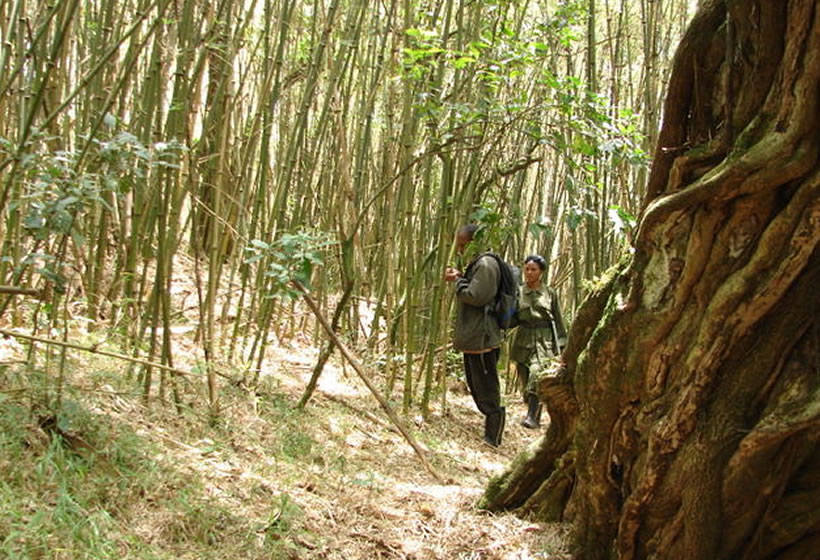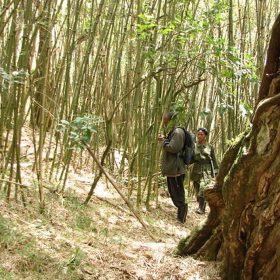We have just started a new study in Mgahinga Gorilla National Park. This is Uganda’s smallest National Park: an area on the slopes of the Virunga Volcanoes that borders Rwanda and Congo (DRC). It is a fun study. It is about bamboo.
The African Mountain Bamboo is a key food for several animals. The young shoots provide a valued food to Mountain Gorillas and to the rare African Golden Monkeys (a species found only in the Virungas). According to UNEP “Mountain Gorillas depend on bamboos for up to 90% of their diet in some seasons. The survival in the wild of the Mountain Bongo [a forest antelope] depends on conservation of the bamboo thickets to which it migrates during the dry season”.
Bamboo are also a valued commodity for people in the surrounding communities who use the larger stems for building, old stems for fire-wood and bean stakes, and use young stems for weaving durable baskets. (In Eastern Uganda bamboo shoots are also eaten smoked … but that is not the case around the Virungas).
Botanists have argued a lot about what to call bamboos. The problem is that botanists like to have flowers to base plant names on … and bamboo doesn’t flower often which makes it hard for them to classify. The African Mountain Bamboo has at least three names to confuse everyone: Arundinaria alpina or Sinarundinaria alpina or Yushania alpina. It is all one species.
The Uganda Wildlife Authority (UWA) has been concerned that the Mgahinga Mountain Gorillas are spending less time in Uganda than in the neighbouring countries. That means that tourists who visit are sometimes disappointed. One suggested reason why the gorillas do not stay longer is that the bamboo was old and dry and not producing the young shoots that would (twice a year) attract the animals to feed. It is also a concern regarding the Golden Monkeys.
Much of the park’s income from tourism depends on the gorillas and the monkeys. At the same time, MGNP management is under pressure from local communities who are eager to access bamboo. UWA asked us at ITFC to help them with a study: if they allowed local people to cut the dry stems would it encourage the bamboo to produce more young shoots?
UWA had already gone ahead selecting an area where local people were allowed to cut and collect dry stems for building and fuel. That was completed a year ago.
So we though we could try and help. We visited Mgahinga in mid September to see the site with UWA staff. We then designed our study. Then in the early days of October, two ITFC volunteers together with MGNP rangers and ourselves spent a few days in training and started the actual data collection. We had two small teams and spent a lot of time counting, measuring and assessing bamboo stems. Our teams included UWA Head Ranger Research and Monitoring: Barebwa Ismael, three UWA Rangers: Uwihoreye Allen, Adrama Francis and Halera George and two ITFC volunteers: Ssali Frederick and Mukasa Joseph. The photographs should give you some feel for these forests. It is high up (about 2,500 meters plus) and cool.
We never saw any wild buffalo, though their tracks were everywhere (the rangers need to carry a rifle just in case — the buffalo are often agressive). We did not see the Golden Monkeys but we heard them close on a few occasions. There was an odd popping sound that carried through the forest as the monkeys snapped off the young nutritious bamboo shoots.
In an ideal world UWA could allow local people controlled access to bamboo without it having any negative impacts … it may even increase the food available for Mountain Gorillas and Golden Monkeys. Perhaps that is true, we don’t know yet. We’ll wait and see the data. That’s applied research.


